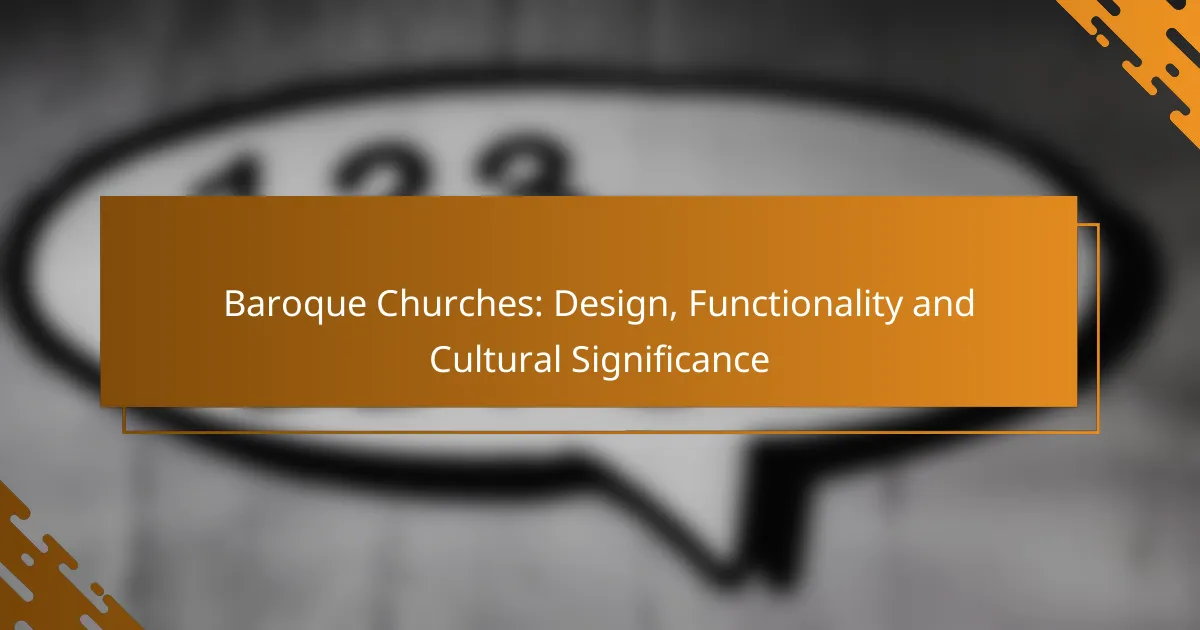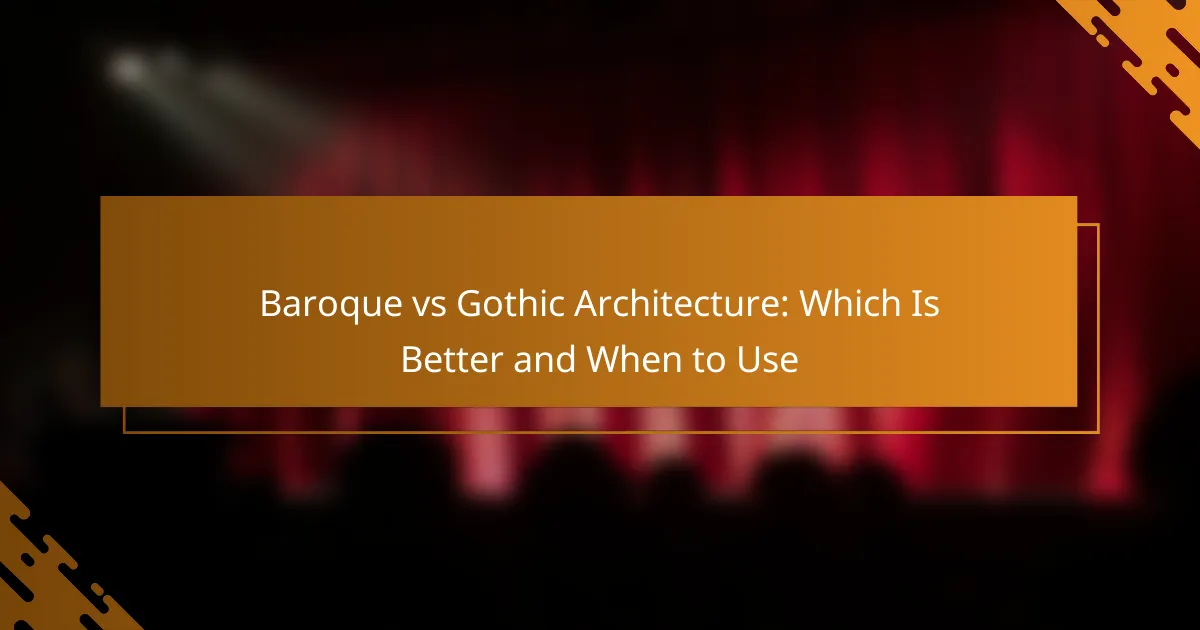Baroque churches in Europe are renowned for their ornate designs and dramatic use of light, which enhance both their aesthetic appeal and their religious significance. These architectural masterpieces reflect the cultural transformations of the Baroque period, serving as vital spaces for worship, community engagement, and heritage preservation. In particular, Italian Baroque churches exemplify the Catholic Church’s power during the Counter-Reformation, embodying a rich blend of artistry and spirituality.

What are the key features of Baroque churches in Europe?
Baroque churches in Europe are characterized by their elaborate designs, dramatic use of light, and intricate spatial arrangements. These features not only enhance the aesthetic appeal but also serve specific religious and cultural functions, reflecting the grandeur of the Baroque period.
Elaborate ornamentation
Baroque churches are renowned for their intricate ornamentation, which includes detailed carvings, gilded surfaces, and vibrant frescoes. This decorative style aims to evoke emotional responses and convey the glory of God, often incorporating motifs such as angels, floral patterns, and biblical scenes.
Common materials used for ornamentation include marble, stucco, and gold leaf, contributing to the overall opulence. The lavish details often draw the eye upward, creating a sense of awe and elevating the spiritual experience.
Dynamic use of light
The dynamic use of light is a hallmark of Baroque church design, where natural and artificial lighting is manipulated to enhance the architectural features. Large windows, often adorned with stained glass, allow sunlight to filter in, creating dramatic contrasts and highlighting specific areas within the church.
Chandeliers and strategically placed candles further amplify this effect, casting flickering shadows that add depth and warmth. This interplay of light and shadow not only beautifies the space but also symbolizes the divine presence.
Complex floor plans
Baroque churches often feature complex floor plans that break away from traditional layouts. These designs may include oval or circular shapes, allowing for a more dynamic flow of movement within the space. The use of multiple chapels and altars encourages exploration and engagement with the sacred environment.
This complexity is intentional, guiding worshippers through a journey of spiritual discovery, with each area designed to evoke different feelings and reflections. The layout often emphasizes the central altar, reinforcing its significance in the liturgical practices.
Integration of sculpture and painting
In Baroque churches, sculpture and painting are seamlessly integrated into the architecture, creating a cohesive artistic experience. Statues of saints and biblical figures are often positioned in niches or on pedestals, while frescoes adorn ceilings and walls, telling stories of faith and devotion.
This integration serves to enhance the narrative of the church, inviting visitors to contemplate the spiritual messages conveyed through art. The three-dimensionality of sculptures contrasts with the flat surfaces of paintings, adding depth and interest to the overall design.
Symbolism in design
Symbolism plays a crucial role in the design of Baroque churches, with various elements representing deeper spiritual meanings. For instance, the use of light symbolizes divine presence, while the grandeur of the architecture reflects the majesty of God.
Architectural features such as domes and towers often signify heaven, while the arrangement of altars and chapels can represent the journey of faith. Understanding these symbols enriches the experience of worshippers and visitors alike, allowing for a more profound connection to the church’s purpose.

How do Baroque churches function in modern society?
Baroque churches serve multiple roles in contemporary society, blending spirituality, cultural preservation, and community engagement. They act as places of worship, heritage sites, tourist attractions, and venues for various events.
Places of worship
Baroque churches continue to function as active places of worship, hosting regular services, ceremonies, and religious events. Many congregations appreciate the rich history and artistic beauty of these structures, which enhance the spiritual experience.
In addition to traditional services, some churches offer community outreach programs, spiritual retreats, and educational workshops, fostering a sense of community among attendees.
Cultural heritage sites
As cultural heritage sites, Baroque churches are often protected by national and international regulations aimed at preserving their architectural and historical significance. These churches reflect the artistic and cultural values of their time, making them vital to understanding local history.
Many countries recognize these sites as important for tourism and education, leading to restoration efforts and funding to maintain their integrity and accessibility for future generations.
Tourist attractions
Baroque churches attract millions of tourists each year, drawn by their stunning architecture and historical importance. Visitors often seek guided tours that highlight the intricate details of the design, artwork, and the stories behind the church’s construction.
In cities with a rich Baroque heritage, such as Rome or Vienna, these churches can be central to cultural itineraries, often featuring in travel guides and promotional materials.
Event venues
Many Baroque churches are utilized as venues for special events, including weddings, concerts, and art exhibitions. Their grand interiors and unique acoustics create a memorable atmosphere for such occasions.
When considering hosting an event in a Baroque church, it’s essential to check for any regulations regarding usage, capacity limits, and necessary permits to ensure compliance with local guidelines.
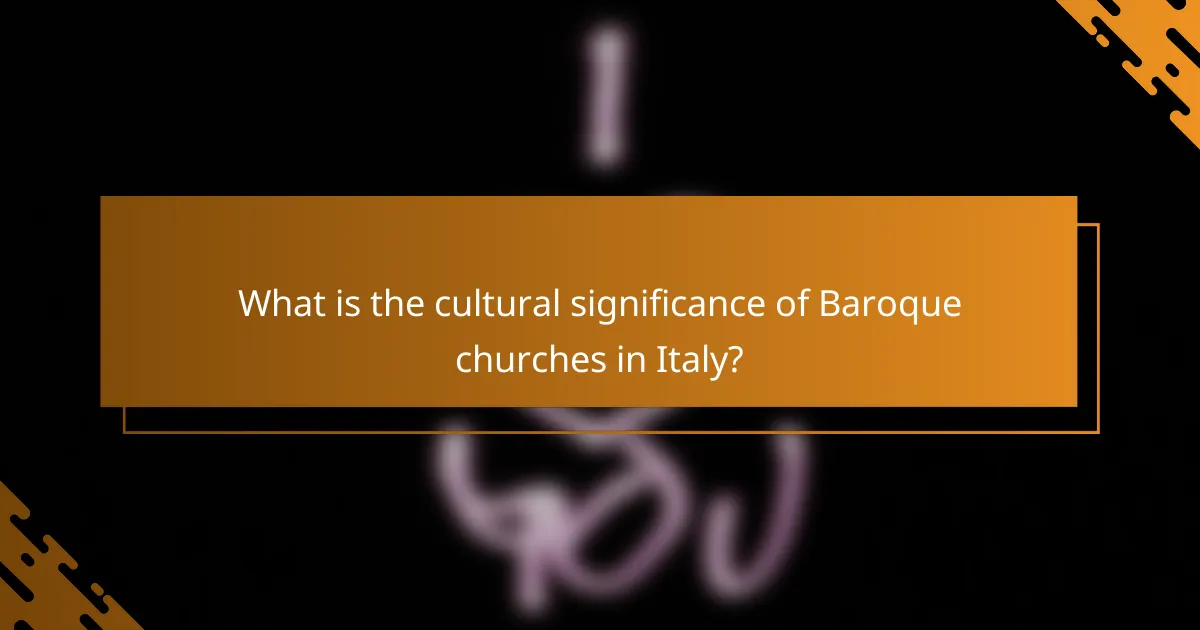
What is the cultural significance of Baroque churches in Italy?
Baroque churches in Italy hold immense cultural significance as they embody the artistic and religious transformations during the Counter-Reformation. These structures not only served as places of worship but also as symbols of the Catholic Church’s power and influence in society.
Reflection of Catholic Counter-Reformation
Baroque churches were designed to reflect the Catholic Church’s response to the Protestant Reformation, emphasizing grandeur and emotional engagement. The architecture, with its dramatic use of light and space, aimed to inspire awe and reinforce the authority of the Church.
Features such as elaborate altars, intricate frescoes, and grandiose domes were intended to attract worshippers and convey religious narratives. This architectural style became a tool for the Church to reclaim followers and assert its dominance during a time of religious upheaval.
Artistic expression of the era
The Baroque period was marked by a flourishing of artistic expression, with churches serving as canvases for renowned artists. Notable figures like Gian Lorenzo Bernini and Francesco Borromini contributed to the design and decoration of these sacred spaces, blending architecture, sculpture, and painting.
This artistic synergy created immersive environments that engaged the senses and communicated spiritual themes. The use of bold colors, dynamic forms, and intricate details reflected the emotional intensity of the Baroque style, making each church a unique masterpiece.
Community gathering spaces
Beyond their religious functions, Baroque churches served as vital community gathering spaces. They hosted not only masses but also festivals, celebrations, and social events, fostering a sense of community among parishioners.
These churches often became the heart of local life, where people could come together in both worship and fellowship. The architecture facilitated large congregations, allowing for communal participation in the spiritual and social fabric of the community.
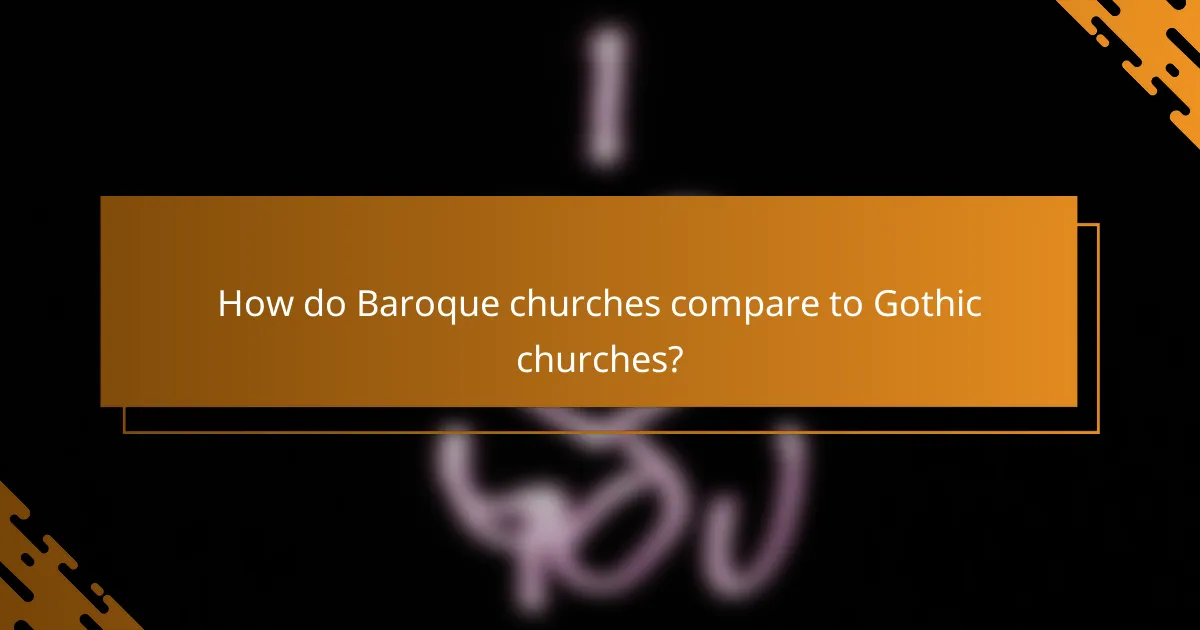
How do Baroque churches compare to Gothic churches?
Baroque churches differ from Gothic churches primarily in their architectural style, symbolism, and historical context. While Gothic churches emphasize verticality and light, Baroque churches focus on grandeur and dramatic effects, reflecting the cultural shifts of their respective periods.
Differences in architectural style
Baroque architecture is characterized by bold, sweeping curves, elaborate ornamentation, and a sense of movement. In contrast, Gothic architecture features pointed arches, ribbed vaults, and flying buttresses, which create a vertical emphasis and allow for large stained glass windows. The interiors of Baroque churches often include frescoes and sculptures that enhance the overall theatricality of the space.
For example, St. Peter’s Basilica in Vatican City exemplifies Baroque design with its grand dome and intricate details, while the Notre-Dame Cathedral in Paris showcases the quintessential Gothic style with its soaring spires and intricate façade.
Variations in symbolism
Baroque churches often symbolize the power and glory of the Catholic Church during the Counter-Reformation, using art and architecture to evoke emotional responses and inspire devotion. The use of light, color, and dramatic contrasts in Baroque design serves to draw the viewer’s eye and create a sense of divine presence.
In contrast, Gothic churches symbolize the aspiration towards heaven, with their vertical lines and light-filled interiors representing a connection between the earthly and the divine. The intricate carvings and stained glass windows in Gothic churches often depict biblical stories, serving both decorative and educational purposes.
Contrasting historical contexts
Baroque architecture emerged in the 17th century as a response to the Protestant Reformation, aiming to reassert the Catholic Church’s influence through awe-inspiring structures. This period was marked by a focus on emotion and sensory experience, reflecting the cultural and political upheavals of the time.
Gothic architecture, on the other hand, flourished from the 12th to the 16th centuries, during a time when the Church was a dominant force in European society. The emphasis on community and collective worship in Gothic churches aligns with the medieval values of the era, focusing on the communal experience of faith rather than individual emotion.
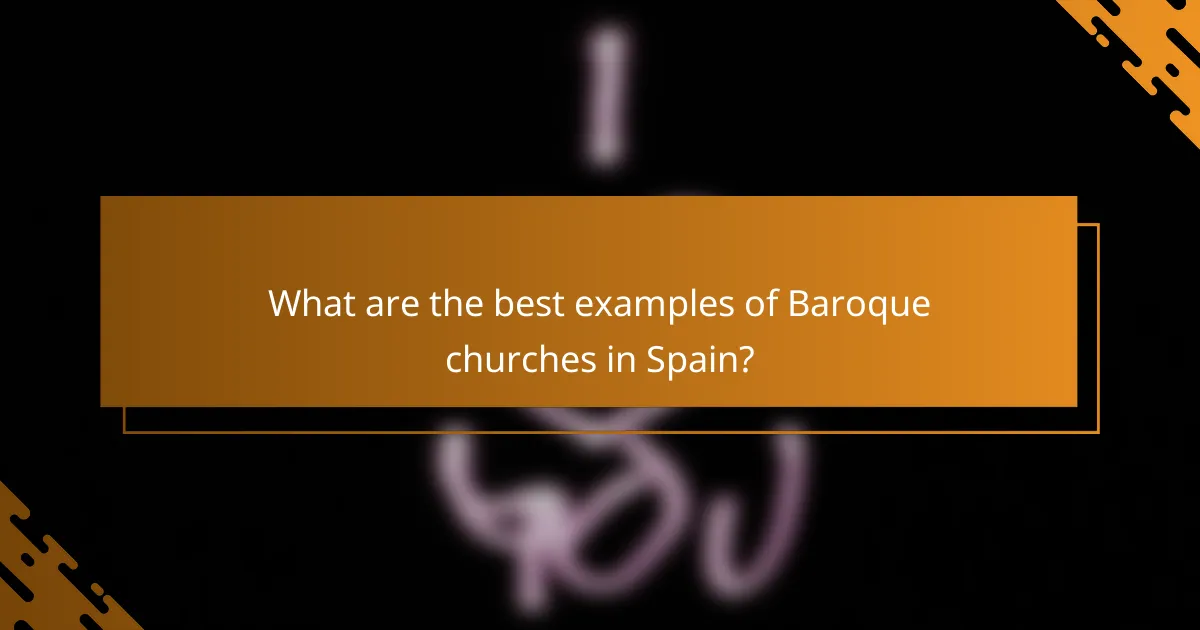
What are the best examples of Baroque churches in Spain?
Spain is home to numerous stunning Baroque churches, showcasing intricate designs and rich cultural significance. Notable examples include the Church of San Luis de los Franceses, the Cathedral of Santiago de Compostela, and the Church of Santa Maria del Mar, each reflecting unique architectural features and historical contexts.
Church of San Luis de los Franceses
The Church of San Luis de los Franceses, located in Seville, is a prime example of Spanish Baroque architecture. Built in the 18th century, it features a striking façade adorned with elaborate sculptures and a stunning interior filled with ornate altarpieces.
This church was originally constructed for the French Jesuits and is known for its unique octagonal shape, which sets it apart from traditional church designs. Visitors often admire its intricate details, including the impressive dome and colorful tile work.
Cathedral of Santiago de Compostela
The Cathedral of Santiago de Compostela is one of the most significant pilgrimage sites in Christianity and a masterpiece of Baroque architecture. Its construction began in the 11th century, but the Baroque façade was completed in the 18th century, adding grandeur to this historic site.
Notable features include the Portico de la Gloria and the impressive bell tower, which exemplify the Baroque style’s emphasis on dramatic expression. The cathedral’s rich history and architectural beauty make it a must-visit for anyone exploring Spanish culture.
Church of Santa Maria del Mar
The Church of Santa Maria del Mar, located in Barcelona, is a stunning example of Catalan Gothic architecture with Baroque elements added later. Built in the 14th century, it is renowned for its impressive stained glass windows and soaring columns.
This church is often celebrated for its harmonious proportions and serene atmosphere, making it a popular destination for both tourists and locals. The blend of Gothic and Baroque styles reflects the evolving architectural trends in Spain during its construction and subsequent renovations.
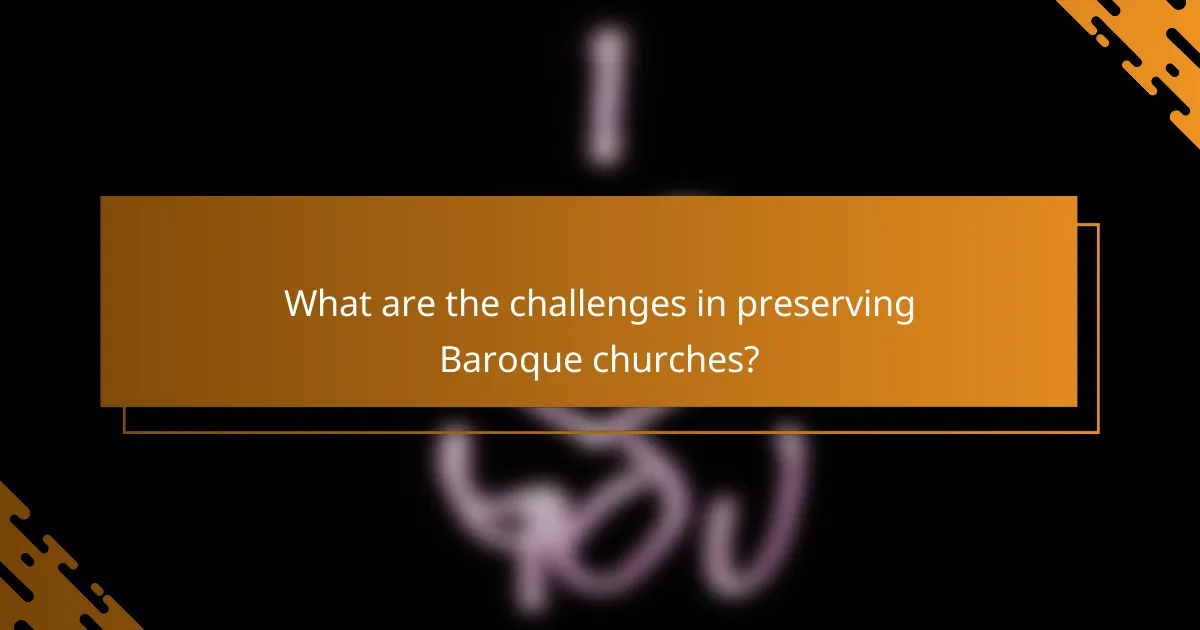
What are the challenges in preserving Baroque churches?
Preserving Baroque churches involves numerous challenges, including structural deterioration, environmental factors, and the need for specialized restoration techniques. These historic buildings often require significant financial investment and expertise to maintain their ornate designs and cultural significance.
Structural deterioration
Baroque churches are often over three centuries old, making them susceptible to structural issues such as cracking, water damage, and pest infestations. Regular inspections are essential to identify these problems early. Restoration efforts may involve reinforcing foundations, repairing roofs, and treating wood for pests.
Environmental factors
Environmental conditions, such as humidity, pollution, and temperature fluctuations, can accelerate the deterioration of Baroque churches. For instance, high humidity can lead to mold growth and damage to frescoes. Implementing climate control measures and using protective coatings can help mitigate these risks.
Financial constraints
Funding for the preservation of Baroque churches often comes from a mix of government grants, private donations, and community fundraising. However, financial constraints can limit the scope of restoration projects. Establishing partnerships with local businesses and cultural organizations can enhance funding opportunities.
Specialized restoration techniques
Restoring Baroque churches requires specialized skills and knowledge of traditional materials and techniques. Craftspeople trained in historic preservation are essential for maintaining the integrity of the original design. Workshops and training programs can help develop a skilled workforce dedicated to these restoration efforts.
